Basketry is probably the oldest art form, although the archaeological record is devoid of the earliest basketry. In his 1904 book American Indian Basketry, Otis Mason writes:
“In ultimate structure, basketry is free-hand mosaic or, in the finest materials, like pen-drawings or beadwork, the surface being composed of any number of small parts—technically decussations, stitches, or meshes, practically separate from one another so far as the effect on the eye is concerned.”
The Plateau tribes made a wide variety of different kinds of baskets. Baskets were often a trade item. In her chapter in Woven History: Native American Basketry, Mary Dodds Schlick writes:
“The Native people of the Columbia Plateau are rich in basketmaking tradition. For thousands of years their ancestors have used the roots, bark and grasses of the region to fashion containers for all their needs. Today a small number of descendants of these basketmakers continue this ancient heritage, an art form known worldwide for fine craftsmanship, variety in design, and beauty.”
In their entry on Plateau basketry in the Handbook of North American Indians, Richard Conn and Mary Dodds Schlick write:
“Basketry is surely one of the most significant, and least appreciated, creative and technological achievements of the world’s peoples. Unlike the more-esteemed potters or beadworkers, basketmakers must create the basic form while simultaneously planning and placing the decoration correctly.”
While baskets can be used for many things, including storage, cooking, and clothing, the process of making baskets is time-consuming, labor-intensive, and requires considerable skill. As manufactured containers become more common on Indian reservations, fewer young women (weavers were mostly women) acquired the necessary skills for making baskets.
By the end of the twentieth century, basket weaving was a dying art on many Indian reservations and on some reservations, there were no women making baskets. Pat Courtney Gold is a Wasco Indian who was raised on the Warm Springs Reservation in Oregon. Growing up, she did not know anyone who could weave the traditional Wasco baskets. She sought out elders on both the Yakama and Warm Springs reservations who could teach her traditional weaving techniques using traditional materials.
 Traditional weavers gather a variety of different plant fibers to be used in their baskets. Shown above, from left to right, are: cattail, tule, sedge, and bur-reed.
Traditional weavers gather a variety of different plant fibers to be used in their baskets. Shown above, from left to right, are: cattail, tule, sedge, and bur-reed.
Cattail is often used because it is easily available and it is a versatile fiber. With regard to tule, the Museum display states:
“Tule is characterized by a thick, round stem and a spongy interior packed with air cells, which makes it both a durable and flexible material for basket making.”
Sedge plants grow along rivers and creeks and in marshy areas. Sedge is a popular material for basket weavers. Bur-reed is found in marshy areas and along lakes, ponds, and streams.
The High Desert Museum in Bend, Oregon, has a special display on Pat Courtney Gold’s baskets. According to the Museum display:
“Pat Courtney Gold’s baskets are at once playful and meaningful. Inspired by traditional Wasco weaving, Gold’s work is full of historical and contemporary references that celebrate past traditions and comment on present day society.”
Her baskets blend modern imagery and materials into Wasco baskets.
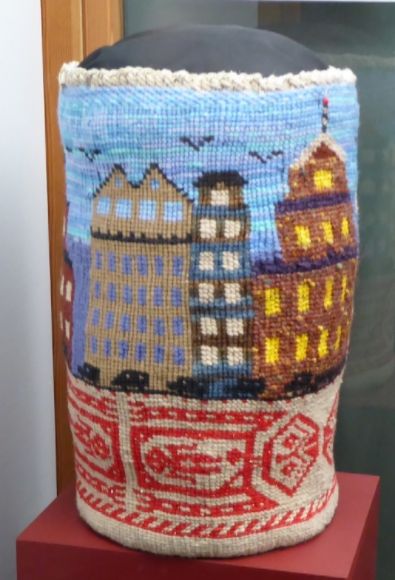 Shown above is Native Culture Endures, a 2010 piece made of cotton, hand spun wool, polyester, and plastic.
Shown above is Native Culture Endures, a 2010 piece made of cotton, hand spun wool, polyester, and plastic.
According to the Museum display:
“The high rise buildings in the basket represent Euro-American culture, which is only 300 years old. The geometric human figures represent American Indians who have lived in this area more than 12,000 years.”
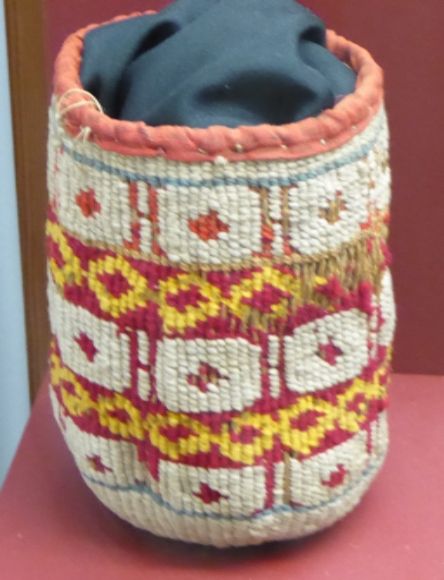 Shown above is a basket made by an unknown artist using plant fibers, yarn, and fabric. In the 1930s, weavers began to incorporate yarn into their baskets. Yarn is easy to work with and provides a wide range of color possibilities.
Shown above is a basket made by an unknown artist using plant fibers, yarn, and fabric. In the 1930s, weavers began to incorporate yarn into their baskets. Yarn is easy to work with and provides a wide range of color possibilities. 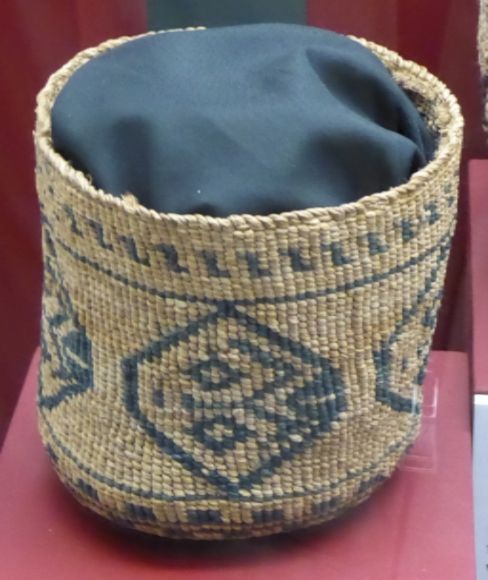 Shown above is a Wasco twined bag from the 1850s. This basket was made with tule and cornhusks.
Shown above is a Wasco twined bag from the 1850s. This basket was made with tule and cornhusks. 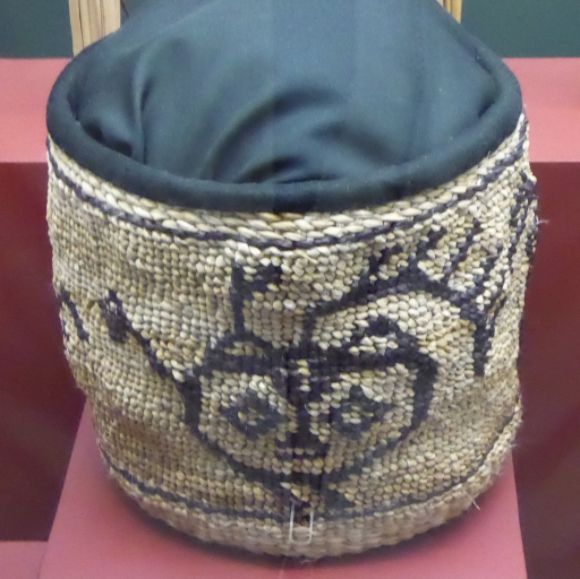 Shown above is Petroglyphs made in 2014 using split cattail leaves. The design highlights the link with the ancient cultures which made the petroglyphs along the Columbia River.
Shown above is Petroglyphs made in 2014 using split cattail leaves. The design highlights the link with the ancient cultures which made the petroglyphs along the Columbia River. 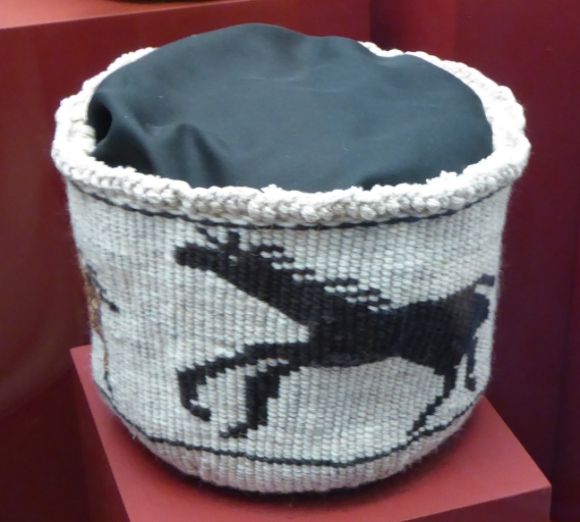 Shown above is Mustangs made in 2007 using cotton, wool, and polyester.
Shown above is Mustangs made in 2007 using cotton, wool, and polyester. 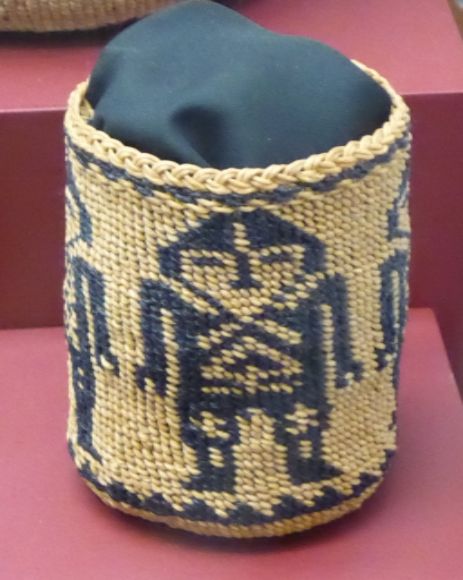 Shown above is Lil Fat Guys made in 2012 using waxed linen. The geometric figures are symbols of Wasco ancestors.
Shown above is Lil Fat Guys made in 2012 using waxed linen. The geometric figures are symbols of Wasco ancestors.  Shown above is a bag made by an unknown artist in the 1910s using plant fibers and leather. The bag features geometric birds and human figures. The human figures represent the ancestors.
Shown above is a bag made by an unknown artist in the 1910s using plant fibers and leather. The bag features geometric birds and human figures. The human figures represent the ancestors. 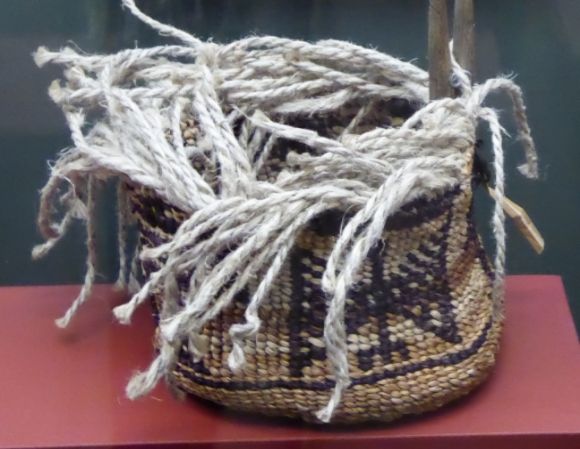 Shown above is a work in progress by Pat Courtney Gold. This work shows how she works materials horizontally (called weft) through stationary vertical elements (warp).
Shown above is a work in progress by Pat Courtney Gold. This work shows how she works materials horizontally (called weft) through stationary vertical elements (warp).
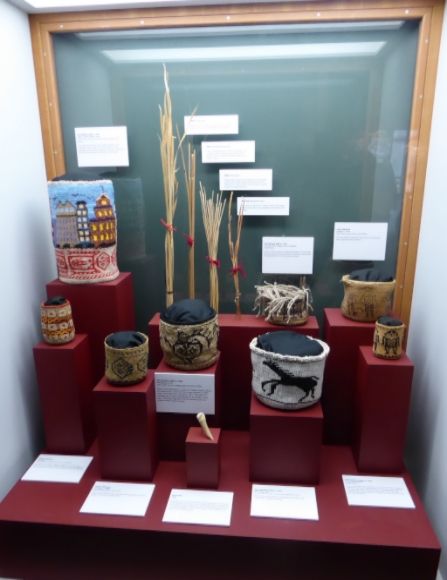
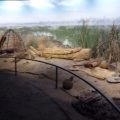
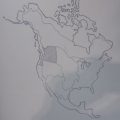

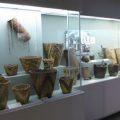
Leave a Reply